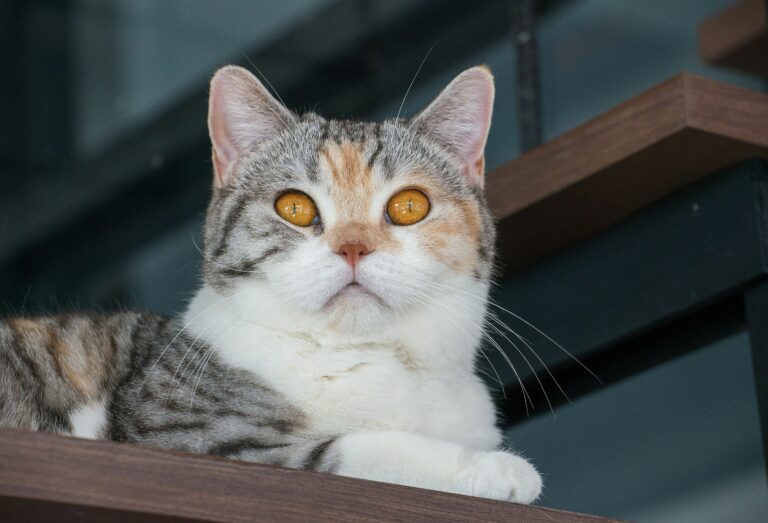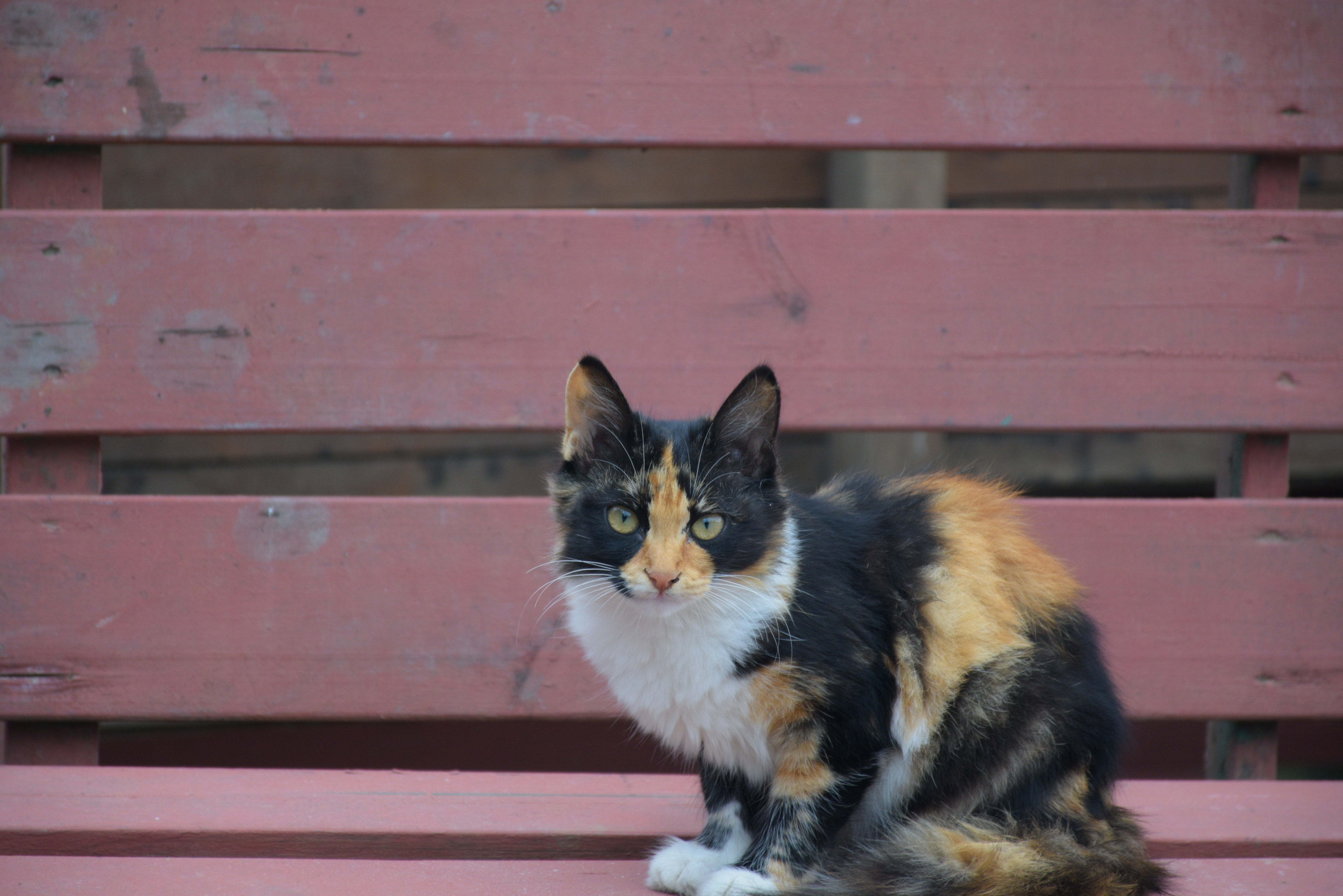Maine Coon
The Maine Coon has now become one of the most popular cat breeds in the world and is enjoying increasing popularity in Ireland, too. This is probably thanks to its authenticity, robustness and excellent character.
The American Shorthair and Longhair cats are well known, but who has heard of the “American Wirehair cat”? This breed is very rare in America and almost unheard of in Europe. The American Wirehair remains an intriguing cat, which, like countless other breeds, was the result of a random genetic mutation. Read on to find out about this mysterious cat breed from New York!

© boyloso / stock.adobe.com
The distinguishing feature of the American Wirehair cat is the structure of its fur. The wiry fur is a result of a chance genetic mutation that is passed on in a dominant gene. It brings with it a dense, slightly rough fur. This is due to a unique structure: each hair is curled at the very tip. Even its whiskers have a certain kink to them. This unique feature gives the American Wirehair an innocently sleepy and ruffled look.
There is also variation within the breed: the stronger the disposition towards the dominant gene, the denser the fur. The genetic mutation itself can be traced back to New York in the 1960s. The dominant nature of the gene meant that the wiry coat was passed onto subsequent generations rapidly.
Due to their shared ancestry, the American Wirehair cat has a similar build to the American Shorthair cat. It is powerful and muscular, with a broad chest and medium length, athletic legs. The American Wirehair has high set cheek bones and attentive, wide, and almost glowing yellow eyes. Just like its close relative, the Wirehair comes in all different colours.
The colours Chocolate and Cinnamon, along with their thinned counterparts are not permitted.
The American Wirehair is an easy-going, lively cat with a tolerant and uncomplicated character that makes it ideally suited to family life. They are very good with kids and love making close friendships with other cats.
The robust breed loves nothing more than playtime. There are also calmer Wirehaired cats, but most will have a taste for hunting in the wild as well as playing with their owner. This makes them very inclined to roam the neighbourhood, but they are equally happy in a flat, provided there is ample room for scratching and other activities to keep them healthy and balanced.
If you know you will be spending lots of time out of the house, you should be leaving your American Wirehair with an interactive cat toy. But even these intelligent games are no match for the company of other cats. The American Wirehair cat is a very social breed, so if you know you will be away from home for long periods of time, you should think about getting a second cat. Even better if this one moves in before the American Wirehair!
 © ada / stock.adobe.com
© ada / stock.adobe.com
You may have already noticed the many similarities between the Wirehair and the American and European Shorthair cats. They all share a lovely and relaxed character and cute looks, but the only point of difference is in their fur…or is it?
The origins of the breed can be traced back to a random genetic mutation that was discovered in New York in the 1960s. The litter of an American Shorthair cat stood out thanks to its unique fur. Sadly, only one kitten survived, but the red and white striped cat won the attention of the breed Joan O’Shea through its unusual fur. He took the kitten in, and named him “Council Rock Farm Adam of Hi-Fi”. By cross breeding with American Shorthairs, a new breed sprung up pretty quickly.
It took another few years before the breed was official recognised by the American Cat Fanciers Association as a subspecies of the American Shorthair cat. To this day, there are very few Wirehair breeders in America, and the breed remains almost entirely unknown in Europe. To maintain genetic diversity and minimise the risk of any genetic diseases being passed on, the Wirehair and Shorthair are still cross bred. Since the gene for the wiry coat is dominant, it is seen in about half of the offspring. The hair may have the curl from birth, or develop it after four to six months. This depends, among other things, on the individual fur constitution. Crossing two Wirehaired cats will give offspring that strongly exhibit this unique fur structure. These kittens are often born with curled whiskers!
Despite their unusual fur, the American Wirehair cat is very low maintenance. The wiry coat does not need any special attention. Using a cat brush once a week should be plenty to minimise hair swallowing. When your cat is moulting, you can give it some paste to ease the passage of swallowed hair.
The usual yearly check-up is recommended for the vet to cast a careful eye over the lungs, heart, and mouth of your cat. This is a great chance to ask about any vaccinations or preventative measures that you may have in mind.
Like all other cats, the American Wirehair loves a diet that is rich in high quality protein, for example Purizon Dry Cat Food. Cats are natural carnivores, so only have limited use for carbohydrates. Sadly, some lower quality foods add plant by-products since these make it easier to make firm dry food.
So, when deciding on a food, keep one eye on the ingredients list! Meat should be at the top of the list, for instance Wild Freedom Dry Cat Food is a good option. But cats need the nutritious offal as well as muscle. These are sometimes listed as animal by-products. Many manufacturers are listing exactly what goes in their food, specifying the source of the offal exactly. This way, you can be sure that your American Wirehair is eating a healthy and balanced diet made up of high quality food with no dodgy bits.
More and more cat owners are turning to raw foods or home-made meals. To ensure that your cat gets adequate nutrients and protein, make sure to inform yourself before trying this. Luckily, this is a growing trend that has even been picked up by some shops that offer raw meats, and in most cases in portions ready to be made into meals.
The American Wirehair cat is almost exclusively bred in the USA. But even there, it is not a common sight by any means. Perhaps it should not come as a big surprise, then, that the cat is a rarity in Europe.
If this breed has caught your eye, it is best to speak directly with reputable breeders.
As with all other breeds, you should only trust breeders that are registered. This is the only way to make sure that the animals come from healthy conditions and are raised in a careful and responsible manner. The carer ensures that the kittens are well fed and live with their mother for at least 3 months before moving into their new homes. This period of time is necessary for the mother cat to pass all its wisdom on to its young. Breeding cats is an expensive hobby, so be prepared for a kitten to set you back several hundred euros. This is a similar price to other breeds.
If you are looking to save money, do not give your custom to someone promising you thorough-bred cats at a low price. These types of sellers will not raise kittens right, and often do not give the mother adequate rest and recovery after each litter, simply using her for profit. These types of breeders are never recognised by any official organisation, and by cutting corners, they will sell you a kitten that may turn out to be very expensive, due to medical costs and malnutrition.
If you are not prepared to dig deep to buy yourself a pure-bred cat, a visit to the local pet shelter is strongly encouraged. These are home to countless cats that would love to be taken into a loving family. Many of these animals were found wandering around, some were given in by their owners, and some came there after the death of their carer. Somewhere out there, your dream cat is waiting for you and your family to pick it up!
We wish you nothing but the very best for you and your new companion!
The Maine Coon has now become one of the most popular cat breeds in the world and is enjoying increasing popularity in Ireland, too. This is probably thanks to its authenticity, robustness and excellent character.
Neva Masquerade – a mysterious name for a mysterious thing of beauty! The Neva Masquerade is the point variation on the Siberian cat and shares many characteristics with this breed.